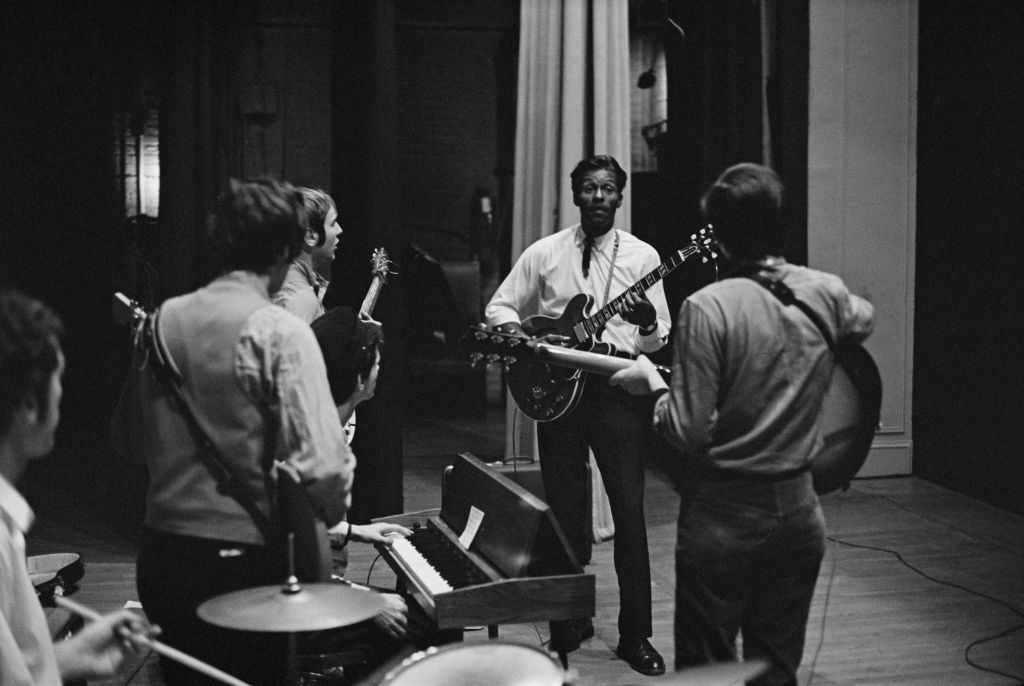5 Pioneering Black Icons Who Shaped Rock and Roll History
Take a deeper look into the contributions of 5 Black rock and roll artists who pushed boundaries to create a new genre of music.
By bfroelich on February 5, 2024

Introduction
When people think of classic rock, they think of big players like the Rolling Stones, Beatles, Pink Floyd, or Led Zeppelin. But the unsung heroes of those bands remain primarily off the charts. Mick Jagger, John Lennon, and countless other musicians have cited Black rock and roll artists such as Muddy Waters and Chuck Berry as influences, and they still influence rock music up to this day.
While many African American singer/songwriter musicians were among the first to transform the sound of rhythm and blues into rock and roll, social segregation leading up to the Civil Rights Era led many record executives to sign and promote knock-off counterparts to Black artists. Because of this, their influence was largely underappreciated in the mainstream until recent years.
To celebrate Black History Month, we’re taking a deeper look into the contributions of 5 Black rock and roll artists who pushed rhythm and blues into uncharted territories, leading to the creation of what we know as classic rock. While some of these artists earned more recognition than others during their heyday, their boundary-pushing work deserves credit.
Fats Domino
When Cleveland disc jockey Alan Freed coined the term “rock and roll” with his rhythm and blues show dubbed “Moondog’s Rock and Roll Party” in 1951, Fats Domino was on heavy rotation. Hailing from New Orleans, Fats Domino fused elements of swing, boogie-woogie, rockabilly, and a sense of rebellion to create a distinctive sound. His hits “Ain’t That A Shame?” and “The Fat Man” demonstrate this best, where a pulsing beat, angsty lyrics, and upbeat tempo transformed the blues into a new sound, capturing the energy of a changing culture post-World War II.
Muddy Waters
Muddy Waters, born McKinley Morganfield in 1913, stands as an indomitable figure in the world of blues whose influence resonates deeply in the roots of classic rock. Widely regarded as the “father of modern Chicago blues,” Waters played a pivotal role in shaping the sound that would later evolve into classic rock. His electrifying guitar work and soulful, passionate vocals captivated audiences. His work as a Black rock and roll artist undeniably influenced rock legends such as Eric Clapton, The Rolling Stones, and Led Zeppelin.
Waters’ raw and expressive approach to the blues, characterized by his signature slide guitar technique, defined the genre and laid the groundwork for the powerful and dynamic guitar-driven sound that became synonymous with classic rock. His impact transcends time, with many classic rock enthusiasts recognizing the debt owed to Muddy Waters for paving the way toward a genre that would echo his influence for generations.
Chuck Berry
Chuck Berry’s stage presence, innovative guitar riffs, and witty lyrics made him a trailblazer who became part of the foundation of classic rock. Hits like “Johnny B. Goode” and “Roll Over Beethoven” have immeasurable impacts on the genre, inspiring the likes of The Beach Boys, the Beatles, and countless others. In 1984, he was part of the first-year class inducted into the Rock and Roll Hall of Fame alongside James Brown, Little Richard, and Fats Domino.
Little Richard
Rock artists owe everything that is flamboyant about classic rock–the outfits, stage presence, and theatrics–to Little Richard. He paved the path for exuberant performances and boundary-pushing sounds, with hits like “Tutti Frutti” and “Good Golly, Miss Molly” that stormed the charts. His uninhibited vocal style was a blueprint for countless rock stars who followed in his wake.
Little Richard’s charismatic force also guided Jimi Hendrix to fame, who played for the artist before he reached his own acclaim as a solo artist.
Ruth Brown
Known as the “Queen of R&B,” Ruth Brown was one of the first artists signed onto the famous Atlantic Records, dubbed “the house that Ruth built” during the 1950s. Her soulful expression and vocal range became a touchstone for many rock and roll artists who admired her ability to convey raw, authentic emotion. Chart-topping hits like “Teardrops from My Eyes” and “Mama, He Treats Your Daughter Mean” resonated across diverse audiences.
Throughout her life, she fell in and out of the spotlight due to a number of challenges, including injury, poverty, and outright segregation. Still, countless rhythm and blues artists throughout the ages feel her impact. She also significantly impacted the material conditions of artists by fighting for fair royalties, founding the nonprofit Rhythm and Blues Foundation to help others in the same frustrating situation she found herself in. In 1993, she was inducted into the Rock and Roll Hall of Fame.
Conclusion
Countless other pioneering rock and roll musicians remain unexplored in this article, including Tina Turner, The Supremes, Bo Diddley, Stevie Wonder, and more. Our intent is not to overlook the contributions of many but to highlight a few Black artists who have undoubtedly influenced the origins of rock and roll and contributed to its popularity. Beyond just Black History Month, we recognize these pioneers for their ingenuity and innovation in rock culture.
Related reading:













